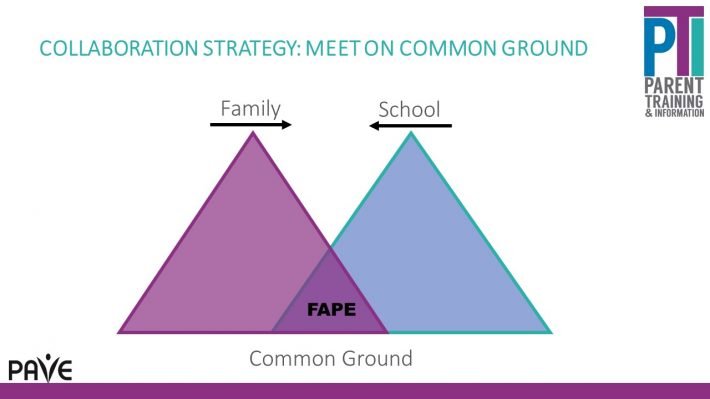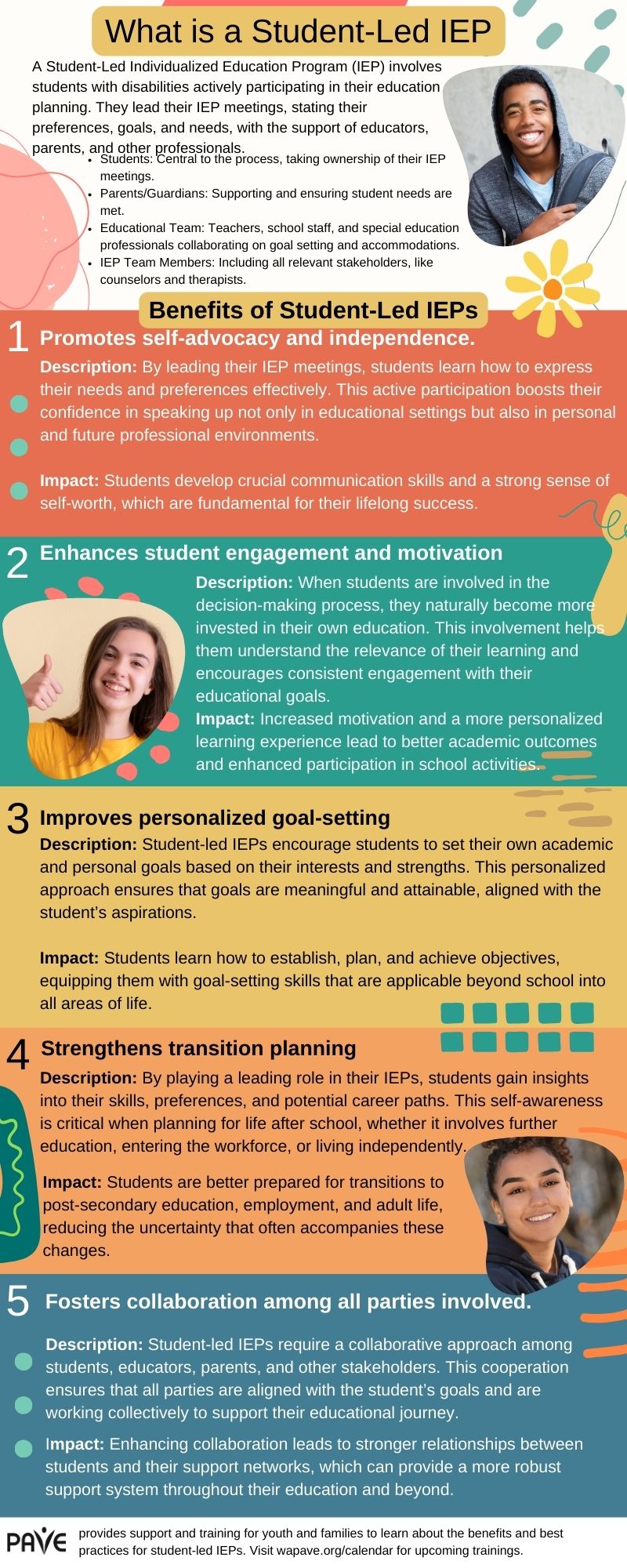A Brief Overview
- If the school denies a request for a special education evaluation or does an evaluation and determines a student is ineligible for services, families have options. Read on for information about some possible next steps.
- When there is a dispute about a district’s evaluation, one option is to request an Independent Educational Evaluation (IEE) from a provider outside of the school district. This article includes a sample letter to help with that process.
- Families are protected by Procedural Safeguards, which guarantee a specific process for special education and offer families the right to file formal complaints when they disagree with school decisions.
- PAVE’s Parent Training and Information (PTI) staff supports families navigating educational services. Click Get Help at wapave.org to request 1:1 support.
Full Article
Parents have a variety of choices if the school denies a request to evaluate a student for special education or if the school does an evaluation and finds the student ineligible for services through an Individualized Education Program (IEP). Here are some options to consider.
Is disability a factor?
A student qualifies for IEP services when three prongs of eligibility are met through evaluation:
- A disability is present.
- The disability condition causes significant adverse educational impact.
- The student needs Specially Designed Instruction (SDI) and/or related services, such as speech, occupational, physical or another therapy to meet an educational need.
Keep in mind that a student does not need to meet all three prongs in order to be evaluated. In accordance with the Child Find Mandate, the school district must evaluate a child if there is a known or suspected disability that may have significant impact on learning. The findings of evaluation consider the three prongs listed above.
When considering whether disability is impacting educational access and outcomes, it’s helpful to review the eligibility categories outlined by federal special education law, the Individuals with Disabilities Education Act (IDEA):
- Autism
- Emotional Disturbance
- Specific Learning Disability
- Other Health Impairment
- Speech/Language Impairment
- Multiple Disabilities
- Intellectual Disability
- Orthopedic Impairment
- Hearing Impairment
- Deafness
- Deaf blindness
- Visual Impairment/Blindness
- Traumatic Brain Injury
In Washington State, children through age 9 may be eligible for services under the category of Developmental Delay. The Washington Administrative Codes (WAC 392-172A-01035) provide detail about eligibility in each category.
Keep in mind that the educational impact of a disability can be assessed with or without a formal diagnosis from a medical provider.
Was your request in writing?
Referrals for special education evaluation are best made in writing. If an initial request was made and denied verbally, start again with a formal letter sent through email, certified mail or in person. PAVE provides a letter template and more information for evaluation requests in an article: Sample Letter to Request Evaluation.
Address the letter to a district special education director or program coordinator, and cc an administrator at the student’s school. Make sure to include the student’s full name and birthdate, a clear statement of request for evaluation in all areas of suspected disability, and details about the concerns. If relevant, attach letters from doctors, therapists or other providers who support the request. The letter should include complete contact information and a statement that parent is prepared to sign consent for the evaluation to begin.
Ask for the decision in writing
The school is required to respond through a formal letter, called Prior Written Notice (PWN), to explain its rationale for moving forward with an evaluation or denying the request. If the school’s rationale for denial is confusing or incomplete, ask for detail in writing.
School evaluators cannot refuse to evaluate because of budgetary constraints. Impacts of COVID-19 delayed some evaluations in spring 2020, but the pandemic is not an explanation for evaluation denial.
Schools cannot refuse to evaluate because they want to try different instructional methods. School staff might use the term Response to Intervention (RTI). Although it might be useful for the school to research its teaching methods, this cannot be the basis for refusing to evaluate a student with a known or suspected disability.
Request a meeting
Discussing a student’s difficulties in a meeting, in-person or virtually, can help school staff understand a parent’s level of concern. A district representative, such as a director of special education, can provide insight about the process and additional options. Parents can invite a support person to take notes and help track the conversation.
Is a Section 504 Plan appropriate?
If a student has a known disability, with some educational impacts, but there is no documented need for Specially Designed Instruction (SDI) and/or related services, the student might qualify for accommodations provided through a Section 504 Plan.
Section 504, which is part of the Rehabilitation Act of 1973, defines disability as an impairment that impacts a major life activity. A formal evaluation is helpful but not required, and parent involvement is best practice. The team asks:
- Does the student have an impairment?
- Does the impairment limit one or more major life activities?
If the answer to these two questions is yes, the school can develop a plan to support the student within the general education setting. Assistive technology and modifications to the curriculum can be part of the plan, which includes individualized accommodations to ensure the student is able to access school in ways that are equitable. PAVE provides an article with more information about Section 504.
File a complaint and/or get outside help
Families are protected by Procedural Safeguards, which guarantee a specific process for special education and offer families the right to file formal complaints when they disagree with school decisions. Mediation, Citizen Complaint, and Due Process are options for dispute resolution in special education. The Office of Superintendent of Public Instruction (OSPI) provides assistance to navigate these processes through a Special Education Parent Liaison.
PAVE’s Parent Training and Information (PTI) staff supports families in their communication with schools. Click Get Help at wapave.org to request 1:1 support.
Another option for support with family/school collaborations is the Governor’s Office of the Education Ombuds.
Request an Independent Educational Evaluation (IEE)
If family caregivers disagree with a district’s evaluation result, the family can request an Independent Educational Evaluation (IEE). An IEE can offer additional information that may support the need for Specially Designed Instruction (SDI) and/or related services.
If the school district denies a request for an IEE at public expense, the district must initiate a due process hearing within 15 calendar days to show that its evaluation was appropriate.
When an IEE request is accepted, the school district provides a list of independent evaluators. Parents have discretion to call each one or to seek an alternative evaluator before choosing who will evaluate the student. The school must consider the results of the IEE when deciding whether the student qualifies for special education programming.
Sample letter to request an IEE
Note: You can email the IEE request letter or send it by certified mail (keep your receipt), or hand carry it to the district office and get a date/time receipt. Remember to keep a copy of this letter and all school-related correspondence for your records. Get organized with a binder or a filing system that will help you keep track of all letters, meetings, conversations, etc. These documents will be important for you and your child for many years to come, including when your child transitions out of school.
Your Name
Street Address
City, State, Zip
Date
Name (if known, otherwise use title only)
Title/Director of Special Education/Program Coordinator
School District
Street Address
City, State, Zip
Dear Name (if known, otherwise use title only):
I am requesting an Independent Educational Evaluation (IEE) for my (son/daughter), (NAME) (BD: 00–00–0000). Please provide me with information about outside agencies in our area that can provide this evaluation.
The school conducted an evaluation (date range of evaluation) to determine whether (NAME) is eligible for special education programming. I disagree with the results of that evaluation for the following reasons: (be as specific as you can; one reason may be that you don’t believe that all areas of suspected disability were appropriately evaluated)
- Use bullet points if the list becomes long.
- Use bullet points if the list becomes long.
- Use bullet points if the list becomes long.
I have attached documentation from (list any outside providers who provided letters supporting your request). Please note that (highlight any particularly important recommendations from those attached documents).
I understand that the school can provide this IEE at no cost to me. I also understand that the school may initiate a due process hearing if denying my request. Upon request, I can provide more detail about my objections to the school’s evaluation.
Please Note: It is the policy of PAVE to provide support, information, and training for families, professionals, and interested others on a number of topics. In no way do these activities constitute providing legal advice. PAVE is not a legal firm or a legal services agency.



